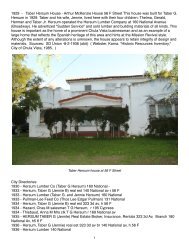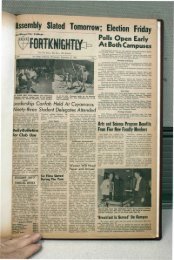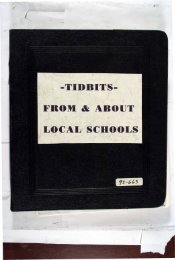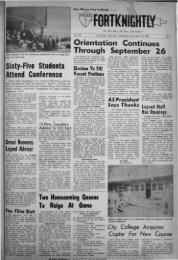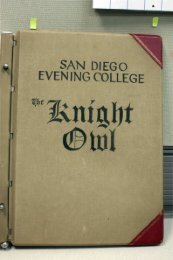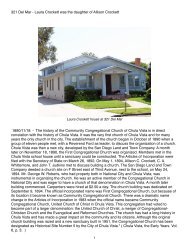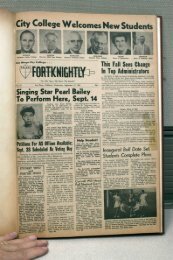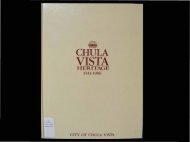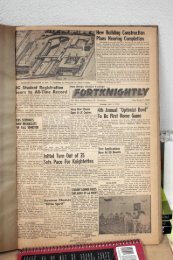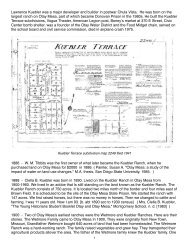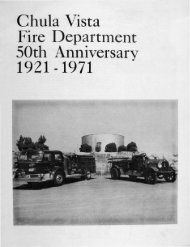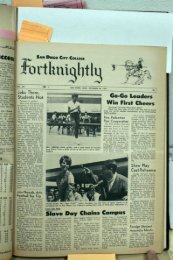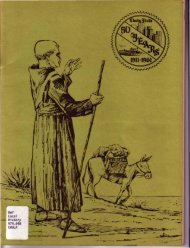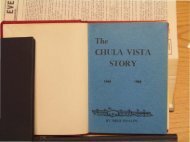doc241 - Schoenherr Home Page in Sunny Chula Vista
doc241 - Schoenherr Home Page in Sunny Chula Vista
doc241 - Schoenherr Home Page in Sunny Chula Vista
Create successful ePaper yourself
Turn your PDF publications into a flip-book with our unique Google optimized e-Paper software.
implicated <strong>in</strong> trouble of the time at Santa Barbara, where he lived, and where he died <strong>in</strong><br />
1862. His first wife was Estefana Pico, and his second Jac<strong>in</strong>ta Pico, both sisters of Pio<br />
and Andrés Pico, of San Diego. A daughter was married to Lewis T. Burton. Don José<br />
Antonio was a man of natural ability, but was dissipated.<br />
CARRILLO, José Raimundo. Founder of the Carrillo family <strong>in</strong> California. A native<br />
of Loreto, born <strong>in</strong> 1749. Son of Hilario Carrillo. Came to California as a soldier, probably<br />
with the first expedition <strong>in</strong> 1769, and rose to rank of capta<strong>in</strong>. Was commandant at San<br />
Diego, 1807-9. He married Tomasa Ignacia, daughter of the soldier Francisco Lugo, the<br />
ceremony be<strong>in</strong>g performed by Junípero Serra at San Carlos, on April 23, 1781. His<br />
early services <strong>in</strong> California were at Santa Barbara and Monterey, com<strong>in</strong>g to San Diego<br />
<strong>in</strong> 1806. He was buried <strong>in</strong> the chapel on Presidio Hill, on November 10, 1809. His only<br />
daughter, María Antonia, became the wife of José de la Guerra v Noriega. His sons,<br />
Carlos Antonio de Jesus, José Antonio Ezequiel, Anastasio, and Dom<strong>in</strong>go Antonio Ignacio,<br />
were all prom<strong>in</strong>ent <strong>in</strong> the early history of California.<br />
CARRILLO, Joaqu<strong>in</strong>. Native of Lower California and a relative (probably a<br />
cous<strong>in</strong>) of José Raimundo. Was liv<strong>in</strong>g as a retired soldier at San Diego <strong>in</strong> 1827. He is<br />
said to have been a good performer on the viol<strong>in</strong>, and was once put <strong>in</strong> the stocks<br />
<strong>Page</strong> 168<br />
by Capt. Ruiz because the latter thought him too slow <strong>in</strong> tun<strong>in</strong>g up to play his favorite<br />
tune. He died before 1840. His widow was María Ignacia Lopez, and their sons were<br />
Joaqu<strong>in</strong>, Julio, and José Ramon. The daughters, Josefa, whose elopement with Henry<br />
D. Fitch has been narrated; Francisca Benicia, wife of M. G. Vallejo; María de la Luz,<br />
wife of Salvador Vallejo; Ramona, wife of Romualdo Pacheco and later of John Wilson,<br />
who lived <strong>in</strong> San Francisco; Mabel Pacheco, who was married to Will. Tevis; Juana; and<br />
Felecidad, wife of Victor Castro.<br />
DOMINGUEZ, Cristobal. Soldier at San Diego before 1800. Died <strong>in</strong> 1825. Rose<br />
to rank of sergeant, and was grantee of San Pedro ranch <strong>in</strong> 1822. His wife was María<br />
de los Reyes Ybañes, at whose house Alfred Rob<strong>in</strong>son resided while <strong>in</strong> San Diego, <strong>in</strong><br />
1829, and to whom he refers as "old lady Dom<strong>in</strong>guez." Part of the American troops were<br />
quartered at her house <strong>in</strong> the Mexican War. Their children were María Victoria, who was<br />
married to José Antonio Estudillo; Luis Gonzaga; Manuel, who is mentioned by Rob<strong>in</strong>son<br />
as Gale's brother-<strong>in</strong>-law at San Diego <strong>in</strong> 1829; María Francisca Marcel<strong>in</strong>a, who was<br />
married to William A. Gale and went to Boston to live; María Elena Ramona; José Nasario;<br />
and Pedro Juan Agapito.<br />
ECHEANDIA, José María. Quite a little has been said about this, the only governor<br />
of California who made his residence <strong>in</strong> San Diego. A few more personal details will<br />
be given at this place.<br />
Before com<strong>in</strong>g to California, he was a Lieutenant-Colonel connected with a college<br />
of eng<strong>in</strong>eers <strong>in</strong> Mexico. Besides Rob<strong>in</strong>son's statement that he was "a tall, gaunt<br />
personage," who received him "with true Spanish dignity and politeness," we learn from<br />
Bancroft that he was "tall, slight and well formed, with fair complexion, hair not quite<br />
black, scanty beard . . . and a pleas<strong>in</strong>g face and expression. His health was very delicate.<br />
In his speech he affected the Castilian pronunciation, noticeably <strong>in</strong> giv<strong>in</strong>g the 'll,' 'c'<br />
and 'z' their proper sounds." He was somewhat absent-m<strong>in</strong>ded at times. Some of his<br />
contemporaries regarded him as a capricious despot, who would carry out a whim without<br />
regard to results; others thought he lacked energy; and still others say he was popu-



